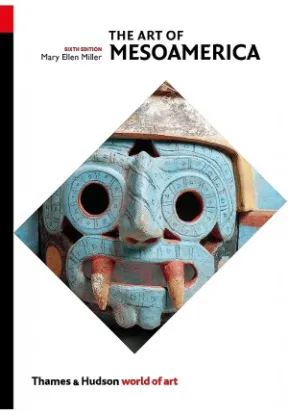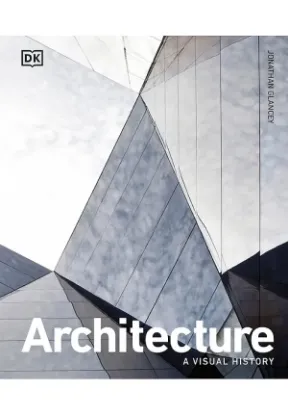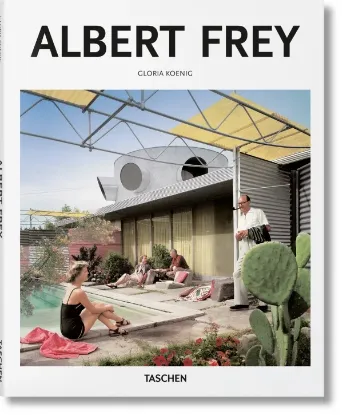Корзина
Поиск
Книги Архитектура и Скульптура
Kuma. Complete Works 1988–Today
7000 грн
Kuma. Complete Works 1988–Today / Автор: , Издательство: Taschen, Серия: , Страниц: 460, Переплет: Твердый, ISBN: 9783836575126
Koolhaas/Obrist. Project Japan. Metabolism Talks
2900 грн 3300 грн
Koolhaas/Obrist. Project Japan. Metabolism Talks / Автор: Rem Koolhaas, Hans Ulrich Obrist, Издательство: Taschen, Серия: , Страниц: 720, Переплет: Твердый, ISBN: 9783836525084
Koolhaas. Elements of Architecture
7140 грн
Koolhaas. Elements of Architecture / Автор: Rem Koolhaas, Издательство: Taschen, Серия: , Страниц: 2333, Переплет: Твердый, ISBN: 9783836556149
Architecture in the 20th Century
3300 грн
Architecture in the 20th Century / Автор: Gabriele Leuthäuser, Peter Gössel, Издательство: Taschen, Серия: , Страниц: 600, Переплет: Твердый, ISBN: 9783836570909
Calatrava. Complete Works 1979–Today
3300 грн
Calatrava. Complete Works 1979–Today / Автор: Philip Jodidio, Издательство: Taschen, Серия: , Страниц: 612, Переплет: Твердый, ISBN: 9783836572415
Eames
830 грн
Eames / Автор: Gloria Koenig, Издательство: Taschen, Серия: Basic Art, Страниц: 96, Переплет: Твердый, ISBN: 9783836560214
The Most Beautiful Villages of Provence
900 грн
The Most Beautiful Villages of Provence / Автор: Michael Jacobs, Издательство: Thames & Hudson, Серия: The Most Beautiful…, Страниц: 21, Переплет: Мягкий, ISBN: 9780500289969
The Field Guide to Supergraphics: Graphics in the Urban Environment
998 грн
The Field Guide to Supergraphics: Graphics in the Urban Environment / Автор: Sean Adams, Издательство: Thames & Hudson, Серия: , Страниц: 384, Переплет: Твердый, ISBN: 9780500021347
Reclaimed
2100 грн
Reclaimed / Автор: Penny Craswell, Издательство: Thames & Hudson, Серия: , Страниц: 272, Переплет: Твердый, ISBN: 9781760761172
Garden City: Supergreen Buildings, Urban Skyscapes and the New Planted Space
1700 грн
Garden City: Supergreen Buildings, Urban Skyscapes and the New Planted Space / Автор: Anna Yudina, Издательство: Thames & Hudson, Серия: , Страниц: 256, Переплет: Твердый, ISBN: 9780500294840
The Art of Mesoamerica: From Olmec to Aztec
850 грн
The Art of Mesoamerica: From Olmec to Aztec / Автор: Mary Ellen Miller, Издательство: Thames & Hudson, Серия: World of Art, Страниц: 296, Переплет: Мягкий, ISBN: 9780500204504
Art and Architecture in Mexico
893 грн
Art and Architecture in Mexico / Автор: James Oles , Издательство: Thames & Hudson, Серия: World of Art, Страниц: 432, Переплет: Мягкий, ISBN: 9780500204061
Architecture: A Visual History
776 грн
Architecture: A Visual History / Автор: Jonathan Glancey, Издательство: Dorling Kindersley, Серия: , Страниц: 416, Переплет: Твердый, ISBN: 9780241514900
Manmade Wonders of the World
972 грн
Manmade Wonders of the World / Автор: DK, Издательство: Dorling Kindersley, Серия: , Страниц: 336, Переплет: Твердый, ISBN: 9780241340714
The Architecture Book: Big Ideas Simply Explained
1071 грн
The Architecture Book: Big Ideas Simply Explained / Автор: DK, Издательство: Dorling Kindersley, Серия: Big Ideas , Страниц: 336, Переплет: Твердая, ISBN: 9780241415030
Neutra. Complete Works
4305 грн
Indoor-outdoor flow meets clean, crisp modernism in the structures of Austrian-American Richard Neutra, master of postwar architecture whose cool, sleek style synthesized technology with nature. This monograph compiles his complete works—nearly 300 private homes, schools, and public buildings—illustrated by over 1,000 photographs, including those of Julius Shulman. View Rating and Reviews Hardcover, 33.2 x 25.7 cm, 3.57 kg, 464 pages
Piranesi. The Complete Etchings
3300 грн
Explore the complete etchings of Giovanni Battista Piranesi, the 18th-century engraver famed for his architectural views of Rome and his imaginary prisons. In this edition, you’ll find all the extraordinary detail and fantasy with which Piranesi shaped not only the European image of Italy, but also an impressive artistic legacy, from Edgar Allan Poe to the moving staircases at Hogwarts. View Rating and Reviews Hardcover, 25 x 34 cm, 3.79 kg, 788 pages
Albert Frey
830 грн
Meet desert modernist Albert Frey, the Zurich-born architect who brought notes of Bauhaus, De Stijl, and Le Corbusier to the West Coast. From his European beginnings, Frey developed a unique architectural brand, one that would redefine midcentury California through sleek, leisurely structures nestled among the arid landscapes of Palm Springs and beyond. View Rating and Reviews Hardcover, 21 x 26 cm, 0.59 kg, 96 pages
California Crazy. American Pop Architecture
2200 грн
In this vivid new examination of a rogue architectural style, discover the roadside structures of California. Fresh discoveries and several pictorial essays explore how these buildings became synonymous with the West Coast and how the power of personal expression championed any architectural establishment with structures eccentric, innovative, and bizarre. View Rating and Reviews Hardcover, 21 x 28.5 cm, 1.82 kg, 324 pages
100 Contemporary Wood Buildings
1100 грн
Travel the world to investigate one of the greatest renaissances in architecture: wood. How has this elemental material come to steal the show at luxury hot spring structures and cutting-edge urban renewal schemes? With 100 projects from China, Chile, and everywhere in between, this global survey explores the technical, environmental, and sensory elements that have inspired a return to timber. View Rating and Reviews Hardcover, 14 x 19.5 cm, 0.97 kg, 632 pages
Homes for Our Time. Contemporary Houses around the World. Vol. 2
3300 грн
This second volume of Homes for Our Time documents a revolution. With photos, plans, and descriptions, it explores new approaches in building and presents resourceful and green private homes. Rejecting “stardom” but celebrating diversity, talents such as Suzuko Yamada, Gurjit Matharoo, and the collective Frankie Pappas truly build our future. Hardcover, 24.6 x 37.2 cm, 3.75 kg, 464 pages
Contemporary Japanese Architecture. 40th Ed.
1439 грн
Since Osaka World Expo ’70 brought contemporary forms center stage, Japan has been a key player in global architecture. Presenting the latest in Japanese building, this book reveals how the likes of Tadao Ando, SANAA, Shigeru Ban, Kengo Kuma, and Junya Ishigami are relinking past, present, and future—building greener and smarter than ever before. Hardcover, 15.6 x 21.7 cm, 1.05 kg, 480 pages
Saarinen
830 грн
From the ubiquitous Knoll “Tulip” chairs and tables to the TWA terminal at JFK Airport in New York, Eero Saarinen was one of the 20th century’s most prominent space shapers, merging dynamic forms with a modernist sensibility across art and architecture. Hardcover, 21 x 26 cm, 0.59 kg, 96 pages
Zaha Hadid. Complete Works 1979–Today. 40th Ed.
1439 грн
From an Olympic ski jump to the world’s largest airport terminal, this book contains the complete works of Dame Zaha Hadid, one of the great architects of the 21st century and the first woman to win the Pritzker Prize. With photos, descriptions and drawings, readers can explore the life and philosophy of the Queen of the Curve. Hardcover, 15.6 x 21.7 cm, 1.06 kg, 492 pages
Prouvé
830 грн
French architect and designer Jean Prouvé innovated crisp, economical construction designs, marrying inexpensive materials and mass production with aesthetic elegance and technical brilliance. His simple, graceful style is an inimitable expression of midcentury innovation, expansion, and growth, and secured his place as one of the century’s most influential designers. Hardcover, 21 x 26 cm, 0.59 kg, 96 pages
Small Houses
3465 грн
Get closer and discover the world’s finest selection of petite architecture. Including the work of Alphaville, Olson Kundig, BIG, Aranza de Ariño, Takeshi Hosaka, and MAPA, this diverse collection of small but delicate houses proves that 100 square meters is plenty of room for intelligent and responsible living. Dream big—build small. Hardcover, 24.6 x 37.2 cm, 3.41 kg, 424 pages
Contemporary Houses. 100 Homes Around the World
3465 грн
Enter 100 of the most beautiful and pioneering houses of the past 20 years. Featuring architects such as Daniel Libeskind, Herzog & de Meuron, and Zaha Hadid, this is a global digest of the nuances, challenges, and opportunities of turning all the emotional and practical requirements of “home” into reality. Hardcover, 25 x 34 cm, 3.74 kg, 592 pages
Modern Architecture A–Z
4305 грн
Explore the A to Z of modern space. From Gio Ponti’s colored geometries to Zaha Hadid’s free-flowing futurism, this comprehensive overview features almost 300 profiles of architects, styles, movements, and trends that have shaped structures from the 19th to the 21st century. Hardcover, 25 x 34 cm, 4.18 kg, 672 pages
BIG. Formgiving. An Architectural Future History
2200 грн
Formgiving. An Architectural Future History, by Bjarke Ingels Group, is the third installment in its TASCHEN trilogy. Ingels looks into the distant future of architecture, addressing the main design trends and the development of AI, sustainability and interplanetary migration, giving form to the world of tomorrow. Softcover, 16.3 x 25 cm, 1.98 kg, 736 pages
Bjarne Mastenbroek. Dig it! Building Bound to the Ground
6090 грн
Dig it! showcases buildings from the past millennia that integrate the ground and the structure. From African churches chiseled from rock and Chinese villages dug into the terrain to a villa built into the cliffs of Capri, this global survey by Bjarne Mastenbroek features analytical drawings by SeARCH and the photography of Iwan Baan. Hardcover with fold-out, 19.3 x 27.1 cm, 2.58 kg, 1390 pages
Десять книг об архитектуре
250 грн
Десять книг об архитектуре / Автор: Витрувий , Издательство: Азбука, Серия: Азбука-Классика. Non-Fiction (мягк/обл.), Страниц: 320, Переплет: Мягкий, ISBN: 978-5-389-13162-0
Беседы об искусстве
300 грн
Беседы об искусстве / Автор: Роден О., Издательство: Азбука, Серия: Азбука-Классика. Non-Fiction (мягк/обл.), Страниц: 320, Переплет: Мягкий, ISBN: 978-5-389-11328-2
Анатомия архитектуры. Семь книг о логике, форме и смысле
1987 грн
Анатомия архитектуры. Семь книг о логике, форме и смысле / Автор: Кавтарадзе С., Издательство: Высшая школа экономики, Серия: Исследования культуры, Страниц: 472, Переплет: Твердый, ISBN: 978-5-7598-1744-4, 978-5-7598-1991-2
Искусство Абхазского царства VIII—XI веков
1260 грн
Искусство Абхазского царства VIII—XI веков / Автор: , Издательство: РХГА, Серия: Archaeologica varia, Страниц: 272, Переплет: Твердый, ISBN: 978-5-88812-469-7
Белый город, Черный город. Архитектура и война в Тель-Авиве и Яффе
720 грн
Белый город. Черный город. Архитектура и война в Тель-Авиве и Яффе / Автор: Ротбард Ш., Издательство: Ад Маргинем Пресс, Страниц: 256, Переплет: Мягкий, ISBN: 978-5-91103-335-4.
Баухаус
1772 грн
Баухаус / Автор: Уитфорд Ф., Издательство: Ад Маргинем Пресс, Серия: , Страниц: 240, Переплет: Мягкий, ISBN: 978-5-91103-563-1
In Memory Of : Designing Contemporary Memorials
3465 грн
In Memory Of : Designing Contemporary Memorials / Автор: Spencer Bailey, David Adjaye, Издательство: Phaidon, Серия: , Страниц: 240, Переплет: Hardback, ISBN: 9781838661441
Jak czytac mosty
390 грн
Jak czytac mosty / Автор: Ian Stewart, Edward Denison, Издательство: Arcady, Серия: , Страниц: 256, Переплет: Paperback, ISBN: 9788321349572
Todd Saunders: New Northern Houses
3045 грн
Todd Saunders: New Northern Houses / Автор: Dominic Bradbury, Todd Saunders, Издательство: Thames and Hudson Ltd, Серия: , Страниц: 256, Переплет: Hardback, ISBN: 9780500343685
100 Contemporary Wood Buildings
3300 грн
Wood is having a great renaissance in global architecture. How has this elemental material become so popular, from luxury hot spring buildings to modern urban renewal plans? With 100 projects from Chile to China, this global survey explores the technical, environmental, and sensory elements that have inspired a return to timber. Hardcover, 25 x 34 cm, 3.92 kg, 624 pages
Modern Architecture A-Z
1100 грн
Modern Architecture A-Z / Автор: TASCHEN, Издательство: Taschen, Серия: Bibliotheca Universalis, Страниц: 696, Переплет: Hardback, ISBN: 9783836556316
Lautner
830 грн
Lautner / Автор: Barbara-Ann Campbell-Lange, Peter Goessel, Издательство: Taschen, Серия: Basic Art Series 2.0, Страниц: 96, Переплет: Hardback, ISBN: 9783836544115
- 1
- 2
Filter by
Характеристики
- Серия
- Переплет
Filter by manufacturer











































